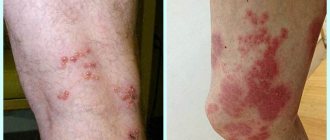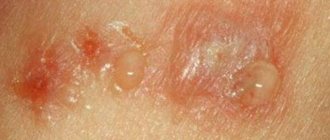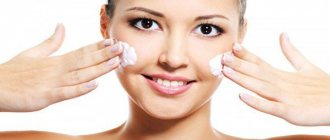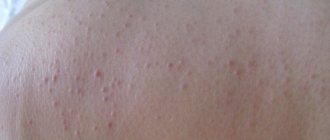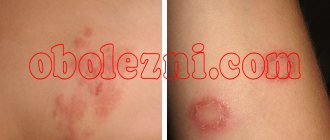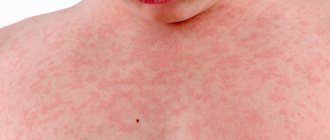Children, as a rule, have not yet developed immunity, so their body may react poorly to various external and internal stimuli. In such cases, an allergic rash occurs in children, a photo of which can be seen further in the article. Young mothers are often frightened when they see redness and pimples on their child’s skin, however, knowing the signs of the main childhood skin diseases, you can take the necessary preventive measures and, if necessary, go to the pediatrician.
In this article you will learn what a child's allergic rash is, what distinctive features and signs it has, what diseases it may indicate, as well as measures and methods for treating and diagnosing these ailments.
What is an allergic rash in children, photo
allergic rash in children photo
Allergic rashes vary in severity and are localized in different areas of the child’s body.
It can appear in different ways, for example, in the form of light pink spots that often resemble nettle marks, or merging spots with a rough surface of eczema. It depends on the strength of the allergen and its cause. Hives on the skin look like spots with different shapes and sizes. If you press on them, you can see inclusions of white color. There are acute and chronic forms of its manifestation. The first is characterized by the appearance in the first hours after interaction with the allergen, so it can be easily identified to exclude contact with it. If a new dose is not given, the symptoms of urticaria disappear within 24 hours. A longer period of manifestation of the rash, as well as its spread with the capture of new areas in the chronic form.
Urticaria is classified according to severity into mild, moderate and severe. The first passes without complications and indicates a weakened immune system of the child. Moderate is often accompanied by fever, swelling and intoxication of the body. In severe cases, the symptoms deepen and usually take several hours from their onset to worsening.
This condition of the child is very dangerous, because it is fraught with Quincke's edema, which leads to the closure of the airways. Dermatitis. The photo shows atopic dermatitis, which has manifestations in the form of an allergic rash. Bright red rashes in the form of crusts protrude above the surface of the skin and are most often localized in the cheeks, crooks of the arms, and legs.
Over time, the rash acquires a rough, rough surface; at the edges, ichor—lymph—protrudes through the thinned walls of the vessels.
There is also contact dermatitis, in which the skin comes into contact with a source of irritation. This may be cosmetics of poor quality, clothes with residues of household chemicals. Dermatitis is accompanied by severe itching, so the child often scratches the rash, which leads to the appearance of wounds and infection.
Children's eczema manifests itself in the form of lesions with blisters that are filled with exudative fluid, as in the photo. After a while, the blisters burst and a dry, itchy crust forms. The location of eczema is the face, neck, ankles, and hands. This manifestation of allergy is dangerous because there is a possibility of a viral infection attaching, as well as its going deeper, and this can result in a disorder of the nervous system and even lead to the death of the baby.
Exudative diathesis. Manifests itself in a life span from 6 months to a year. The nature of the rash can be seen in the photo. An allergic rash, which has symptoms similar to childhood eczema, can be inherited. If this occurs, then rashes on the skin appear periodically.
Exudative diathesis, in addition to external manifestations, can also affect the baby’s nervous system, causing sleep disturbances, the child becomes irritable and tearful.
If an allergic rash occurs, this serves as a signal that the child’s immune system is malfunctioning. With such disorders of the body, a protective reaction is triggered by ordinary, completely harmless substances, such as food, pollen, cosmetics, and sometimes skin sensitivity occurs after the use of medications.
There are conditional allergens to which the body most often causes an allergic reaction: Food. These are usually honey, chocolate, strawberries, nuts, cow's milk, eggs, seafood, red fish. Food allergies manifest themselves in the form of hives or swelling of the face or larynx.
Pollen. An allergic skin reaction is seasonal and occurs when certain plants bloom. How does it manifest? The skin turns red, swelling and rhinitis appear. Household chemicals and cosmetics. The photo shows the child’s body’s reaction to a household allergen.
Some substances found in baby creams, cosmetics, and powders can cause an allergic rash. The reaction with a skin rash can be immediate or gradual as the body accumulates the allergen.
Medicines. It is impossible to predict the body's reaction to any group of drugs. Therefore, children prone to allergies to medications should be treated with caution. An allergy occurs to a specific group, for example, penicillin or with heavy use of drugs that reduce immunity.
In this case, antihistamines are prescribed that can reduce the manifestations of an allergic reaction. Pets. Animal skin contains small scales that float in the air. If they enter the respiratory tract, they can cause allergies.
Therefore, signs of allergy may not appear when in contact with a cat on the street, and if you spend a long time with the animal indoors at home, the concentration of the allergen increases. Symptoms of an allergy to animals include sneezing, watery eyes, and rashes on the face.
A skin rash in children can be a consequence of an allergen and more. For example, a rash can occur from prickly heat, and can also be a companion to an infection (rubella, measles). Therefore, it is very important to diagnose the disease in a timely manner and begin treatment.
To identify the allergen, a blood test is taken from the baby or a skin test is done. If the rash is painful and spread over a large area, then the skin test is replaced by checking the blood for the presence of histamine. First, you should determine the source of the allergen, and then exclude contact with the child.
To further prevent allergic manifestations in children, comprehensive treatment must be used. It includes the use of antihistamines, which are aimed at reducing the production of histamine, thereby eliminating the manifestations of the rash. To eliminate itching, local anesthetics that block synapses and ointments are used.
They promote healing and reduce tissue swelling. Thanks to the local effect of ointments, a secondary effect is achieved, which prevents scratching of wounds and infection.
Treatment of allergic skin rashes takes place under the strict supervision of a doctor without independently changing the dosage of the drug. If at least one factor contributing to the manifestation of allergies occurs, then in order to reduce the likelihood of its occurrence, you need to take a number of preventive measures.
Source: dermatolog.guru
Causes
The causes of the disease in adults and children are the body’s intolerance to certain foods. This reaction is inherited, but its occurrence is also influenced by negative factors. If a food allergy develops, the reasons may be:
- giving up breastfeeding and switching to artificial nutrition;
- early refusal of breast milk, when the baby still needs it;
- premature introduction of complementary foods;
- excessive consumption of foods that are allergens;
- pathologies of the gastrointestinal tract;
- intestinal dysbiosis, which occurs at an early age;
- poor nutrition.
The occurrence of an allergic reaction is promoted by the consumption of the following products:
- undiluted milk;
- soy;
- chocolate;
- honey;
- citrus;
- chicken eggs;
- crayfish and other representatives of the crustacean family;
- sea fish;
- nuts;
- fruits, berries and vegetables in red and orange shades;
- melon.
Types of rash
The rash is a variety of changes on the skin.
This disease most often appears in certain painful conditions. In order to determine the causes of the rash, it is necessary to first understand what types the different types of rashes are classified into. Erythema toxicum on the face and body often occurs in newborns. Erythema looks like light yellowish papules and pustules reaching approximately 1.5 cm in diameter. Sometimes red spots appear. The skin may be completely affected or partially affected. Rashes can often be noticed on the second day of a child’s life, which gradually disappear over time. Some types of rashes primarily form in summer and spring. Since the release of sweat gland components is very difficult in the warm season. As a rule, rashes appear on the head, face and in the diaper rash area. Miliaria appears in the form of spots, pustules and blisters.
Skin requires constant care. Atopic dermatitis in a child is also called neurodermatitis. Many children suffer from this disease, but the symptoms can be completely different, depending on the individual characteristics of the body. As a rule, the disease is accompanied by eczema, runny nose, and asthma.
Dermatitis appears in the form of red papules with liquid inside. In this case, the child feels itching, especially at night. Dermatitis appears on the face and cheeks, and also slightly on the extensor parts of the limbs. The skin peels off and becomes noticeably thickened.
An allergic reaction may be Quincke's edema. Occurs when interacting with certain foods or medications. The patient has difficulty breathing because the larynx is blocked.
In this case, swelling forms in the legs and arms. Hives are also considered an allergic form of rash. It may occur due to certain foods, pills, as well as due to an allergic reaction to the sun or cold. Erythema infectiosum is caused by parvovirus B19, which is transmitted by airborne droplets.
The most common symptoms of the disease may be low fever, redness and the appearance of spots on the face, as well as on the body. The incubation period of the rash in a child ranges from 5 days to one month. Headaches and a slight cough are quite likely. The rash is especially pronounced on the extensor parts of the limbs and on the feet. Children with this disease are not contagious.
After a few days, the temperature drops and a small rash appears on the body, which in appearance resembles pink spots, they can be felt. After a couple of days they become invisible and gradually disappear. Chicken pox, otherwise known as chickenpox, is a viral disease that is similar in structure to herpes.
A large number of children under the age of 15 suffer from this disease. Chickenpox is transmitted through the air. The latent period reaches three weeks. Before the rash appears, the child may have a headache and pain in the abdomen.
Sepsis is a disease that involves blood poisoning. The disease is accompanied by a sharp rise in temperature and nausea. In the first days, growing rashes in the form of bruises appear on the child’s body. Most often, such bruises appear on the legs and arms, and scars often form.
In some cases, small children with the development of sepsis may experience shock with a fatal outcome. Thus, it is necessary to immediately prescribe treatment after an accurate diagnosis is established, since it threatens negative consequences. Measles is considered a fairly common disease; the incubation period lasts up to two weeks.
During the week, general weakness and malaise of the whole body continues. In addition, children develop a dry cough, red eyes, and fever. On the inside of the cheeks you can notice small dots of white or gray tint, which disappear after a day.
Next, rashes appear on the face, behind the ears, and gradually descend to the chest area. After a couple of days, rashes appear on the feet, the patient’s face becomes pale.
Rubella is considered to be a viral disease that can be seen in children from 5 to 15 years old. Its incubation period is extended to 21 days. Until this moment, the child may not feel anything, that is, symptoms do not appear at all. After the latent period, a slight malaise occurs, the temperature gradually rises, and the lymph nodes on the back of the head are noticeably enlarged.
Scarlet fever is caused by group A streptococci and is transmitted by airborne droplets. The incubation period lasts for a week. Then the temperature rises, general malaise and sore throat are felt. Rashes appear already on the third day of illness. As a rule, the rash affects the face, with the exception of the nasolabial triangle.
Infectious mononucleosis is caused by the Epstein-Barr virus and often resolves without a rash. It is difficult to become infected with infectious mononucleosis. However, if this disease manifests itself, the patient’s lymph nodes at the back of the neck, as well as the liver and spleen, become enlarged.
The patient's cheeks are burning, his tongue is raspberry-colored. The rash disappears after a week. On the third day of the disease, tonsillitis appears and the temperature rises. In less than a week, rashes of different shapes and sizes appear, which tend to disappear quickly and without a trace.
Source: lecheniedetej.ru
Symptoms
Symptoms of food allergies in adults and children most often appear immediately after consuming the product that causes the reaction. The body's response may also be delayed. The allergen can accumulate and make itself felt only a few hours after eating, or less often - after a few days.
Signs of pathology may not necessarily be open. There are hidden symptoms that are more dangerous for the body. A person consumes a product for a long time to which the immune system reacts sharply, but there are no external signs. The result is a life-threatening condition. These include Quincke syndrome and other dangerous pathologies.
Overt manifestations of food allergies:
- rash on the epidermis;
- itching and numbness of the mouth;
- allergic rhinitis;
- swelling of the lips and tongue, as in the photo below, as well as the mucous membranes of the oral cavity.
If you have a food allergy, the symptoms may be different:
- nausea accompanied by vomiting;
- problems with stool;
- heaviness in the stomach;
- colic in the intestines.
If allergic enterocolitis occurs, you will experience loose stools with clear mucus in the stool. Associated symptoms include headaches, dizziness and weakness.
Causes of allergies in children
In most cases, parents and doctors are faced with atopic dermatitis in children associated with food allergies. The main reason for its occurrence is associated with the immaturity of the digestive system: a relative deficiency of digestive enzymes, immaturity of the liver, which is not yet able to neutralize foreign protein, and increased permeability of the intestinal wall, due to which foreign protein enters the blood.
As a result of the action of these factors, the baby’s immune system is constantly in contact with foreign antigen proteins. This is manifested by symptoms of atopic dermatitis, as well as a runny nose and indigestion.
The child grows up, and with age the activity of the liver, stomach and intestines increases. The intestinal mucosa becomes a reliable barrier to food allergens. They cannot penetrate the blood, which means allergies are a thing of the past. Risk factors for food allergies. There are a number of factors that increase a child’s susceptibility to allergic reactions:
- Heredity. Atopic dermatitis in children whose parents suffer from allergies is much more common.
- Binge eating. More often, food allergies occur in a child who overeats. Food is not completely digested. Poisonous food breakdown products are absorbed into the blood. The liver is still immature and cannot neutralize these wastes. A foreign protein - antigen enters the blood from the intestines and causes an allergic reaction. The body is “freed” from food allergens through the skin. Some harmful substances are eliminated through sweat.
- Constipation. The contents of the intestines undergo fermentation processes. Excellent conditions are created for the proliferation of pathogenic bacteria. The intestinal mucosa becomes even more permeable to allergens. They enter the bloodstream and trigger another round of food allergies.
- The period of growth and development of the child's bones. During this period, there is a relative calcium deficiency, which is also considered a risk factor for food allergies.
- Overdose of vitamin D, which provokes calcium deficiency.
There is also contact dermatitis, in which the main condition of the disease is considered to be external influence - contact of a foreign substance with the child’s skin.
Source: enterosgel.ru
Symptoms and signs
The clinical manifestations of allergies are individual for each person (from a banal skin rash to Quincke's edema and anaphylactic shock).
Manifestations of the disease on the skin are rashes of various types, spots, swelling in certain areas. It is worth noting that with allergies, the body often itches, especially the affected areas. Most often, allergies on the body are manifested by hives, dermatitis, acne or eczema, but in some cases, skin manifestations of an allergic reaction can cause an exacerbation of psoriasis. Urticaria is a skin manifestation of an allergic reaction that looks like a nettle burn. In the mechanism of development of urticaria, the leading role is played by the formation of edema in the papillary layer of the skin, the cause of which is the inflammatory process.
Hives may be the only manifestation of an allergy on the body or be combined with other symptoms (rhinitis, conjunctivitis, cough). The main symptom is reddish-pink, raised above the surface of the skin, itchy spots of varying sizes and shapes.
They can be single, multiple or merging, located on the body in a symmetrical or chaotic order. After relief, allergies go away without leaving any traces. Eczema is an allergic disease localized in the superficial layers of the skin and manifested by the appearance of bright red swollen areas with many fluid-filled blisters.
After the bubbles open, superficial weeping erosions are formed, which are subsequently covered with crusts. The process is accompanied by severe itching and burning.
Depending on the method of penetration of the allergen into the body, allergic dermatitis can be divided into the following forms: contact; toxicoallergic or toxicoderma; phytodermatitis; atopic. Contact dermatitis develops at the site of direct contact of the skin with the allergen.
As a rule, the cause of this form of allergic reaction is aggressive allergens (household chemicals, building materials, cosmetics, external medications). One of the forms of contact dermatitis that develops when the skin is exposed to pollen or the milky sap of certain plants.
The most common cause of this type of pathology can be citrus fruits, primrose, as well as ornamental plants belonging to the ranunculaceae, lily or euphorbia families. Depending on the causes and clinical manifestations, experts distinguish several types of eczema:
- true or idiopathic - the rashes are mainly localized on the face and back of the hands, characterized by the frequent addition of a secondary infection of a bacterial or fungal nature;
- microbial - in most cases, develops around infected skin lesions; the distinctive feature is a clearly limited form of the rash and the presence of peeling at the edges. Typical localization is the back of the hands and shins, scalp;
- seborrheic – develops on the head, face and upper back and chest. It begins with the formation of dense nodules covered with fatty crusts, from which plaques and larger lesions then form;
- professional can occur when exposed to irritants associated with a person’s profession;
- fungal or mycotic - this form of the disease develops against the background of fungal infections of the skin, is most often located on the legs and is characterized by a ring-shaped lesion;
- dyshidrotic - lesions are localized on the soles and palms, eventually spreading to the feet and hands, often small blisters merge to form one large multi-chamber one. May be accompanied by trophic changes in the structure of the nail plates;
- callous or tylotic - a systemic form, located on the skin of the soles and palms, subsequently spreading to the entire body.
Diathesis or atopic dermatitis develops in children as a result of immaturity of the digestive tract, due to which the absorption of certain substances does not occur completely and the immune system perceives them as allergens. The most common complication of atopic dermatitis in a child is the addition of a secondary infection due to scratching of a constantly itchy rash.
Toxicallergic or toxicoderma. This form of allergic dermatitis occurs as a result of an allergen entering the body through the respiratory or digestive system, insect bites, or injection of medications. Moreover, depending on the allergen, the rash looks different.
Psoriatic rashes often resemble contact dermatitis or eczema; in order to determine the diagnosis, you must consult a doctor. In addition, an allergic reaction is one of the etiological factors in the development of exacerbations of psoriasis. Allergy acne is the mildest clinical manifestation of this disease.
Most often they appear when eating fatty, smoked or fried foods; in this case, adjusting the diet is sufficient for treatment.
But in some cases, in order to cure allergic acne, it is necessary to determine which allergen is the cause of their occurrence and eliminate contact with it.
Source: allergycentr.ru
The dangers of allergies to food and medications
Dr. Komarovsky confirms the statement of most doctors that food and drug allergies are the most dangerous. Anaphylactic shock is a common complication of the disease. This condition is dangerous for infants and older children.
How dangerous is the dosage form? Both forms are characterized by a complication in the form of Quincke's edema in the larynx. Also, the danger lies in the occurrence of toxic effects on the body, fungal infection of the mucous membranes and disruption of the intestinal microflora.
When will it pass?
You can get rid of allergies quickly; after a few days, acne begins to go away on its own. If in children under one year of age the rash does not go away for a long time, you should consult a doctor.
It is impossible to say how long the reaction to the allergen lasts. Each person is individual. However, the average duration of allergies in children is 1–3 weeks. Several factors influence when the disease will go away. The first is the portion of food eaten that caused the rash and other symptoms, the second is the effectiveness and correctness of the selected treatment, the third is the state of the baby’s immunity, especially when the child is at least a year old.
Treatment of childhood allergic rash
Allergic rashes are not only symptoms of a fairly serious disease - allergies, but are also fraught with complications in themselves. A child, scratching itchy areas of skin, can introduce a staphylococcal, streptococcal or fungal infection into the wounds, which will cause the development of more serious skin lesions and necessitate drug treatment.
Treatment of an allergic rash in a child should begin with a visit to a doctor who can determine the allergen that caused the rash.
If diagnosis is neglected, such rashes will become chronic and can lead to destructive changes in the skin (scars, scars). Once the cause of the allergic reaction has been identified, the child's contact with substances or foods containing this allergen should be completely excluded.
Antihistamines are prescribed as a medicinal treatment to alleviate the child’s condition and reduce itching: Claritin, Diazolin, Fenkarol and others. These medications neutralize substances in the child’s body that cause an immune reaction.
It should be remembered that among antihistamines there are drugs that have a sedative effect. Among them are Diphenhydramine, Tavegil, Suprastin - they cause a hypnotic effect and slow down reactions. Therefore, when prescribing such drugs to a child, it is necessary to carefully monitor his behavior and not leave the baby alone.
In addition to taking antihistamines, you should use topical gels and ointments that will reduce itching and prevent infection of the allergic rash. All drugs, both internal and local, should be prescribed only by a doctor and used in the dosage that he recommended.
If an allergic rash is accompanied by watery eyes, nasal congestion and swelling of the face, you should immediately consult a doctor or call an ambulance. The described symptoms may indicate angioedema, which, when developing, can cause swelling of the tongue and larynx, leading to suffocation.
Source: allergolife.ru
Traditional treatment
This is possible, but for this you need to prevent allergies, and not delay treatment of allergies in children from a very early age, because severe and chronically advanced forms can lead to irreversible changes in the child’s organs and tissues.
The first thing to do is to conduct a thorough diagnosis of allergies to identify which specific allergen the body is reacting to (allergen analysis).
This is a big step towards success. Since accurate knowledge helps to most effectively design the treatment of allergies in children. Next, you need to avoid contact with the identified allergen as much as possible, after which the allergy sufferer will definitely feel better.
However, it is often impossible to completely avoid encountering an allergen, so with each contact the child will have a renewed allergic reaction. It is constantly recurring allergic exacerbations that lead to the severity and progression of allergies in children. Therefore, we cannot stop there.
If necessary, competent drug therapy is needed to help symptomatically relieve acute allergy symptoms. But we must remember that antihistamines, as well as hormonal drugs used to treat allergies in children, only mask the absence of allergy symptoms. As soon as the drug is discontinued, the allergy returns again.
In order to really permanently and effectively reduce the body’s excessive sensitivity to some substance (allergen), an allergist or children’s allergist prescribes ASIT, which results in the body adapting, stopping the progression of allergies in children and stabilizing the condition.
While controlling allergies, which is very important, every child has a chance to “outgrow” allergies during puberty. During this period, powerful stress occurs in the body, which helps the immune system adapt and rebuild. As a result, allergies cease to appear and bother you. However, a predisposition remains, so prevention of allergies, monitoring the condition and periodic examinations will help prevent exacerbations of allergies throughout life.
Source: forpost.ua
Folk remedies
When a child is allergic to pollen, an inflammatory process begins that affects the respiratory system, eyes, and skin. Seasonal manifestations of a negative reaction can be treated using folk remedies.
If a child has a food allergy, symptoms may appear on the surface of the skin in the form of a rash, as well as other signs of a reaction (difficulty in the gastrointestinal tract, cough). This type of irritation can be treated using folk remedies.
Calamus root and St. John's wort (1 tablespoon each) are poured into 1 liter of water. You need to cook the mixture for 10 minutes. After filtering and cooling, you can use the decoction to gargle. You can cure your child by relieving him of rashes and redness on the skin with the help of healthy decoctions and juices. Dandelion leaves are ground in a blender.
Juice is squeezed out of the pulp, which is diluted with water (1 part juice to 5 parts water). You need to drink 1 tablespoon per day. Vegetable juice will be a healthy and tasty medicine. To prepare it, take parsley, cucumber, carrots, and beets. You need to drink a glass of it a day. Regular tea can be replaced with a decoction of strawberry leaves.
You can eliminate skin rashes using brewed rose hips, to which 2-3 bay leaves are added. After infusion, the child needs to drink 20 ml of decoction 2-3 times a day. Treatment of food irritation is carried out using crushed egg shells. For children, a daily dose of 1/4 teaspoon is recommended.
You can eliminate an allergic reaction with the help of mumiyo. A universal remedy helps relieve swelling of the throat, as well as skin rashes. When taken orally, it is necessary to dilute 1 g of the composition in 1 liter of warm water. You need to drink from 20 to 100 ml per day, depending on the age of the child.
If it is necessary to cure a skin rash, then a more concentrated solution is made (1 g of mumiyo per 100 ml of water). Affected surfaces should be lubricated for 20 days. For skin damage due to allergies in children, it is recommended to take baths with the addition of decoctions of medicinal plants.
You can use chamomile infusion (2-3 tablespoons per 0.5 liter of boiling water), oak bark, leaves and branches of black currant. After infusion, the finished decoctions are filtered and added to the water collected in the bath. The optimal time for bathing a child is 10–15 minutes. Redness and itching on the skin in children caused by food allergies can be relieved by an ancient folk remedy - a bath with herbs.
Relief from urticaria and dermatitis. Children often develop a rash on their skin when exposed to various allergens. It can be treated with folk remedies. Plant decoctions and vegetable juices work well against skin itching and rashes. You can replace regular tea with mint tea, which is prepared at the rate of 1-2 tablespoons of the plant per glass of boiling water.
You can treat urticaria and dermatitis with yarrow (1-2 tablespoons per glass of boiling water). You need to infuse the product for 1.5 hours. After this, it is recommended to give it to the child three times a day, 80 g.
To speed up the process of cleansing the body in case of an allergic reaction, you need to drink celery juice. It also normalizes the functioning of the gastrointestinal tract. Treatment for rashes on a child’s skin is carried out using compresses and rubbing. To prepare a compress, you can use grated potatoes, which are applied to the blisters for 30 minutes.
Beetroot juice can be used as a lotion. The peeled root vegetable is placed in a cup and filled with cold water (2 liters). After a week of infusion, the prepared solution can be lubricated on the affected surfaces of the skin. It is recommended to treat the rash with dill juice and used tea bags. Such rubbing will help relieve itching and irritation.
For seasonal and year-round manifestations of allergies, it is necessary to give children an infusion of mint (1 tablespoon) and boiled milk. After insisting, it can be given to the child 3 times a day. The disease can be treated using a decoction of coltsfoot and violet. The infusion should be given 2 tablespoons twice a day.
Before instillation, it is recommended to rinse the nose. To do this, add a tablespoon of salt to a glass of warm water. Using a syringe, the solution is injected into the nasal passage and then poured out of it.
Essential oils help normalize breathing, eliminate mucous discharge from the nose, and also get rid of swelling. They are widely used in the treatment of allergic reactions affecting the respiratory tract. Add a few drops of oil to warm water. The child needs to breathe this composition for at least 15 minutes.
A proven folk remedy - inhalation with essential oils or herbs - will help cope with allergic rhinitis in a child. Various treatment procedures can be performed at home.
The undoubted advantage of such therapy is its accessibility, simplicity and safety. After all, in the process of preparing decoctions, ointments and drops, only natural ingredients are used.
It is important that the baby does not have an allergic reaction to herbs. Indeed, in this case, it will be possible to observe the opposite effect when the allergic reaction intensifies.
Source: allergiyainfo.ru
Methods of treating the disease
Treatment of food allergies in children begins with certain tests. In laboratory conditions, a blood test is taken from the child; an increased content of immunoglobulin E and eosinophils will indicate the presence of allergic processes in the body.
How to treat the disease? The doctor prescribes a cleansing enema and Activated carbon tablets, sorbents, enzymes, antihistamines. A good medicine for treating allergies is Suprastin. It is allowed to be taken by children from 1 year to 14 years.
Doctors regularly prescribe Enterosgel to young patients. This drug belongs to the group of enterosorbents; it is prescribed for various intoxication lesions of the body. The medicine is given to children under one year of age and adults. Children are also prescribed Polysorb from birth.
Treating food allergies is possible with home remedies. Treatment with folk remedies includes the use of herbal infusions. For their preparation, many herbs are used, for example, horsetail, nettle, St. John's wort, licorice, calamus.
Attention! Any medications cannot be taken independently, as well as homemade decoctions.
The disease can be cured using complex therapy, the main thing is the regular use of tablets and folk remedies.
Prevention
If your baby has a predisposition to allergies, you need to adhere to several rules: increase the duration of breastfeeding, minimize the risk of possible allergens getting into the baby's diet, do wet cleaning in the room as often as possible, and periodically carry out antifungal treatment.
You should also not smoke around your child or in the apartment where he lives, use an air purifier, and keep closets with clothes and books closed. It is advisable to buy bedding and clothes for the child from non-allergenic materials, avoid contact of the child with animals, and use harmless household chemicals when washing. At the first suspicion that the child has an allergy, you should not self-treat. This will not only not help eliminate the problem, but will also make it worse.
A timely visit to an allergist will help to detect the disease earlier and begin to take action. When choosing a clinic, it is better to give preference to specialized institutions that treat children.
Source: webdermatolog.ru
